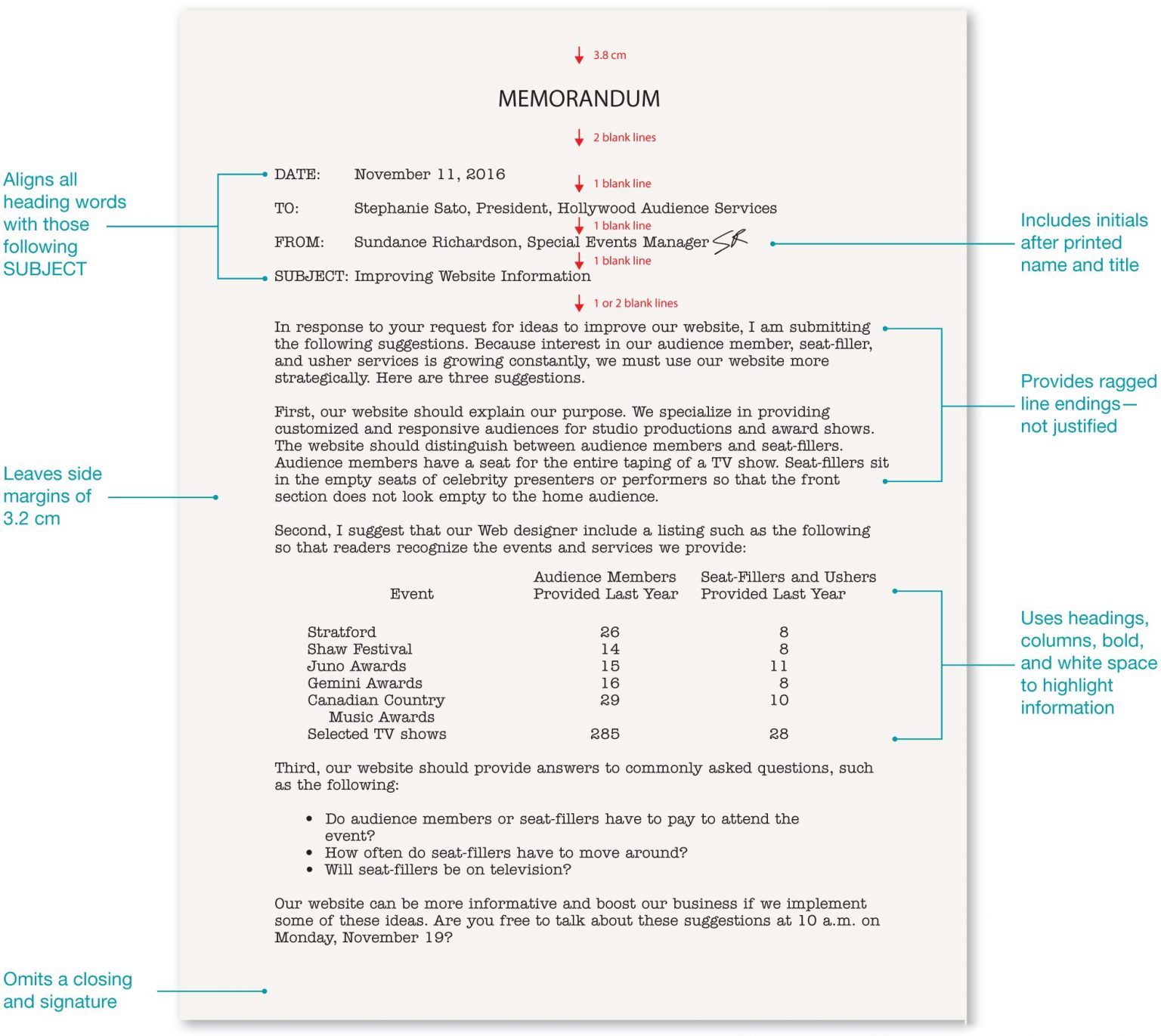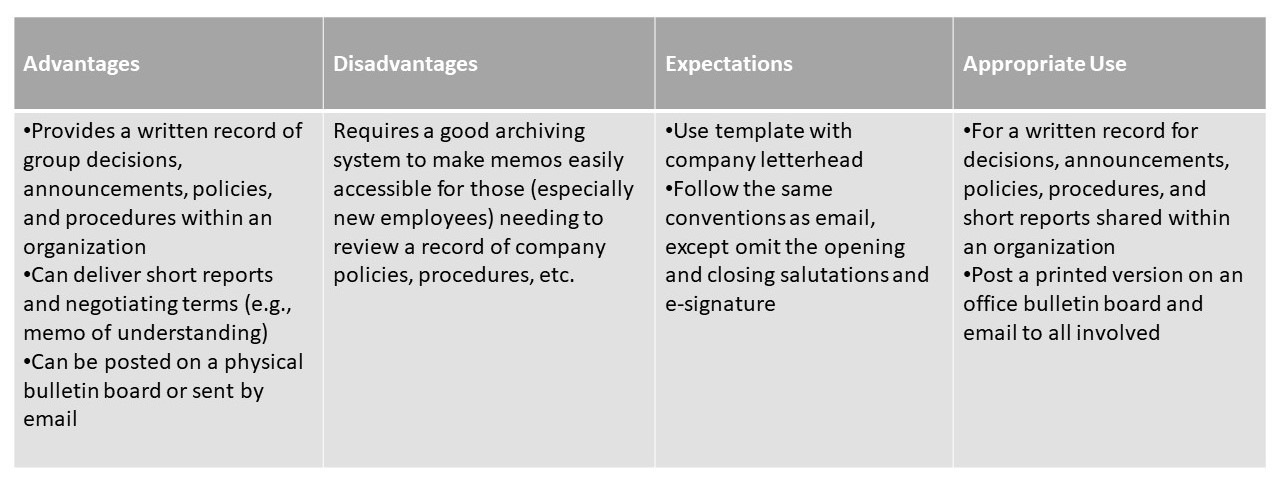37 Memos
Learning Objectives
After you have completed this chapter, you will be able to
- describe when to use a memo
- format a memo
- describe common types of memos
The information in this chapter is adapted from Unit 22: Memos in Communication at Work by Karen Vance (Kwantlen Polytechnic University[1], made available by Pressbooks under a CC BY-NC-SA 4.0 license
What is a Memo?
A memo (or memorandum, meaning “reminder”) communicates policies, procedures, short reports, or related official business within an organization. It assumes a one-to-all perspective, broadcasting a message to a group audience, rather than to an individual. Memos are objective in tone and avoid all personal bias or subjective preference, especially because they may have legal standing when reflecting policies or procedures. Accuracy is therefore paramount in memos lest ambiguities result in mistakes that then become legal matters (Business Communication for Success, 2015).
Watch the video below to learn about how to write clear business memos.[2]
Before exploring memos in more detail, let’s consider the advantages, disadvantages, and occasions for using memos:
Memo Purpose
A memo’s purpose is often to inform, but it occasionally includes an element of persuasion or call to action. Memos are most appropriately used for internal organizational messages that may be too detailed or too long to be communicated via an email. Memos allow organizations to clearly spell-out for all employees what is going on with a particular issue. If budget cuts are a concern, then it may be wise to send a memo explaining the imminent changes. If a company wants employees to take action, it may also issue a memorandum about that action. In this way, memos often represent the business or organization’s interests. They may also include statements that align business and employee interest, and underscore common ground and benefit (Business Communication for Success, 2015). Memos usually carry nonsensitive and routine information; therefore, most memos will be written using the direct approach.
Memo Format
A memo has four distinct sections: header, purpose statement, body, and call-to-action. Memos often have letterheads with the word “MEMO” written clearly with the company name and logo at the top of the page. Below this are the header fields identifying the recipient, author, date, and subject much like you would see in an email. In fact, email’s header fields are based on those traditionally found in memos, so the same principles for what to include here, such as how to title the document in the subject line, are true of emails.
Unlike emails, memos omit the opening salutation but, from there, are similar in their three-part message organization with an opening, body, and closing. Always direct-approach, the memo message opening states the main point, the body supports this with details, and the closing gives action information or a summary. Let’s examine each section of a memo in more detail.

Header: The header of a memo provides logistical information:
- The Date provides the complete and current date. To avoid confusion, always spell the date out: June 5, 2020, not 06/05/2020.
- The To line identifies to whom the message is addressed. Depending on the size of company or department, the receivers full name and title may also be included.
- The From line identifies the sender of the message. Again, full name and title may be required.
- The Subject line identifies the topic of the memo. Subject lines must be specific, composed of descriptive nouns (8 words or less), not full sentences, and each major word should be capitalized.
Purpose: The first paragraph of the memo contains the most important information. The reason for writing the memo as well as the action requested of the receiver should be stated directly in this paragraph. Get to the point as quickly as possible using only 1-2 sentences to stated the information

Body: The middle paragraphs of a memo provides more detailed information about the context or problem and the task, assignment, or action required. The body of a memo may be multiple paragraphs depending on memo’s subject matter. Each paragraph should be between 3 – 5 sentences. Use of graphic highlights (lists, tables, headers, etc.) are encouraged for this section of the memo to achieve conciseness and to increase readability. Make sure the body paragraphs answer receiver questions and clearly identify an deadline and people involved.
Call-to-Action: The final paragraph of a memo summarizes content, states next steps, invites feedback, provides resources, and offers contact information. The final paragraph should also ensure goodwill but avoid cliche sayings. Use specific and concrete statements to ensure receiver understanding.
Example:
Vague: Please contact me at your earliest convenience.
Concrete: Please call my direct line (ext. 222) by end of day Monday, June 22.
Types of Memos
Request Memos
A request memo does exactly what it’s name suggests: requests an action of the receiver. An effectively composed request memo will clearly state the requested action within the opening paragraph of the memo. The explanation or justification for the request is included in the body of the memo while being polite and using the “you” view will ensure the reader understands the benefits of completing the requested action. Requests that require a great deal of effort, time, or resources should follow the indirect approach to have the best chance of persuading reader.
Reply
Similar to the request memo, the name of this memo also suggests its purpose: replying to a previous correspondence. When constructing the reply memo, respond to each request in the order that they are made. Use the direct approach as the receiver will want your immediate response to each request without searching. If necessary, provide additional information that may be useful to the original request. Responding immediately to a request memo, especially if you’ve receive a request for higher ups in the organization, shows efficiency and professionalism.
Follow-up Memos
A follow-up memo provides a written record of an oral conversation. For example, a memo that records discussion of a recent meeting that confirms the time, place, date, participants, meeting purpose and decisions. Committing the basic facts, decisions, and issues discussed in a meeting ensures that memory does not become the basis for moving forward. Writing follow-up messages protects you and the receivers by ensuring a shared and common understanding of the important details and facts. The more important the oral conversation, the more important it is to ensure a written conformation of the discussion is created.
Additional Resources
As cited by Vance:
Bovee, C., Thill, J., & Scribner, J. (2016). Business communication essentials (4th ed.). Toronto, ON: Pearson Canada Inc. Retrieved from http://www.pearsoncanada.ca/highered/product-showcase/new-solutions-for-core-foundations-from-pearson-canada/business-communication-essentials-fourth-canadian-edition-4e
GCFLearnFree.org. (2018). Writing a clear business memo [Video file]. Retrieved from https://www.youtube.com/watch?v=eHZdnldGuls
Kopywriting Kourse. (2020). How to write an effective memo. Retrieved from https://kopywritingkourse.com/how-to-write-a-memo/
Guffey, M., Loewry, D., & Griffin, E. (2019). Business communication: Process and product (6th ed.). Toronto, ON: Nelson Education. Retrieved from http://www.cengage.com/cgi-wadsworth/course_products_wp.pl?fid=M20b&product_isbn_issn=9780176531393&template=NELSON
Meyer, C. (2017). Communicating for results (4th ed.). Don Mills, ON: Oxford University Press. Retrieved from https://oup-arc.com/access/meyer-4e-student-resources#tag_case-studies
Perkins, C., & Brizee, A. (2018, March 23). Memos: Audience and Purpose. Purdue OWL. Retrieved from https://owl.english.purdue.edu/owl/resource/590/1/
wikiHow. (2018, May 14). How to write a memo. Retrieved from https://www.wikihow.com/Write-a-Memo
For more on memos, see the following resources:
Purdue OWL’s four Memos modules, starting with Audience and Purpose
- Vance, K. (n.d.). Communication at work (adapted for KPU from Jordan Smith's (n.d.) Communication @ work). https://kpu.pressbooks.pub/communicationsatwork/ CC By 4.0 license ↵
- GCFLearnFree.org. (2018, May 11). Writing a clear business memo [Video]. YouTube. https://www.youtube.com/watch?v=eHZdnldGuls ↵


